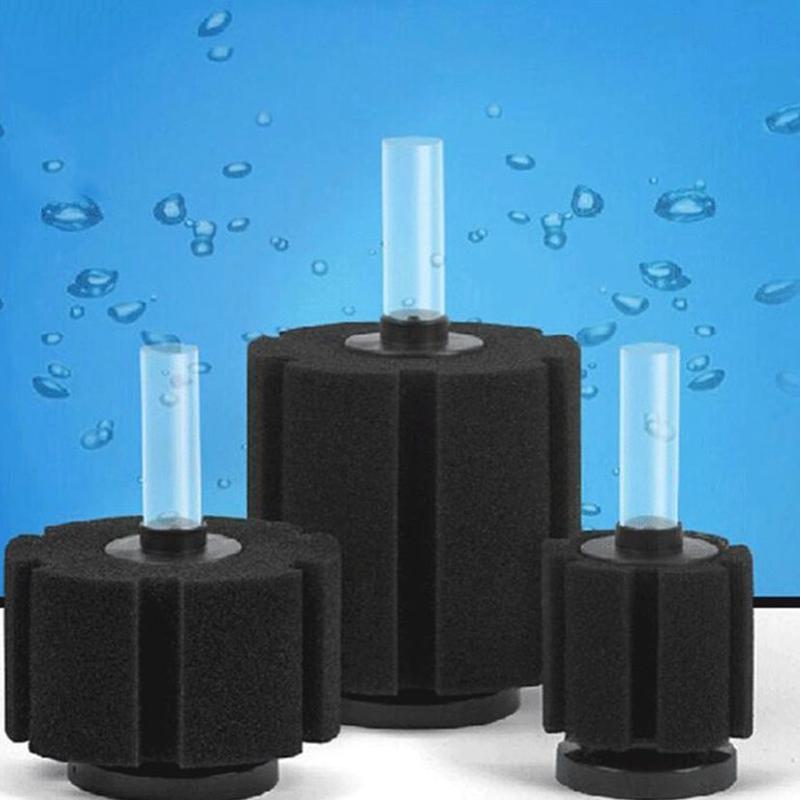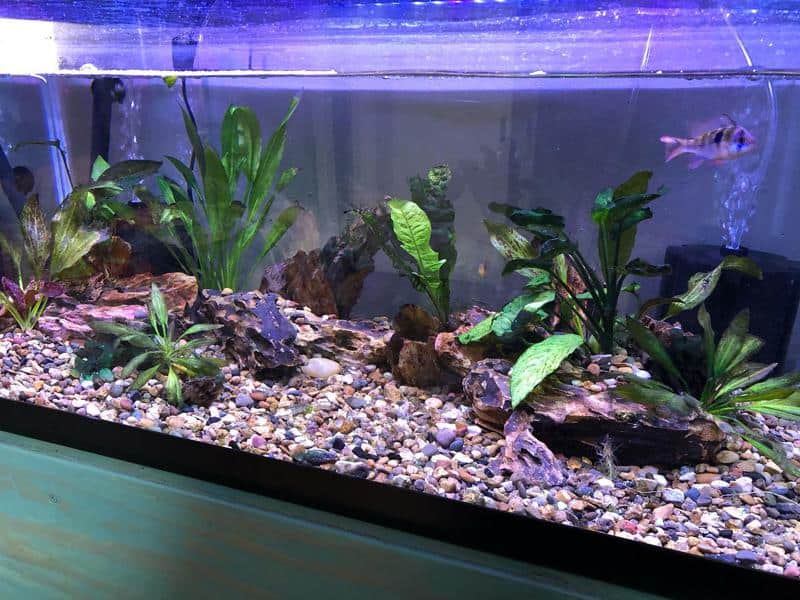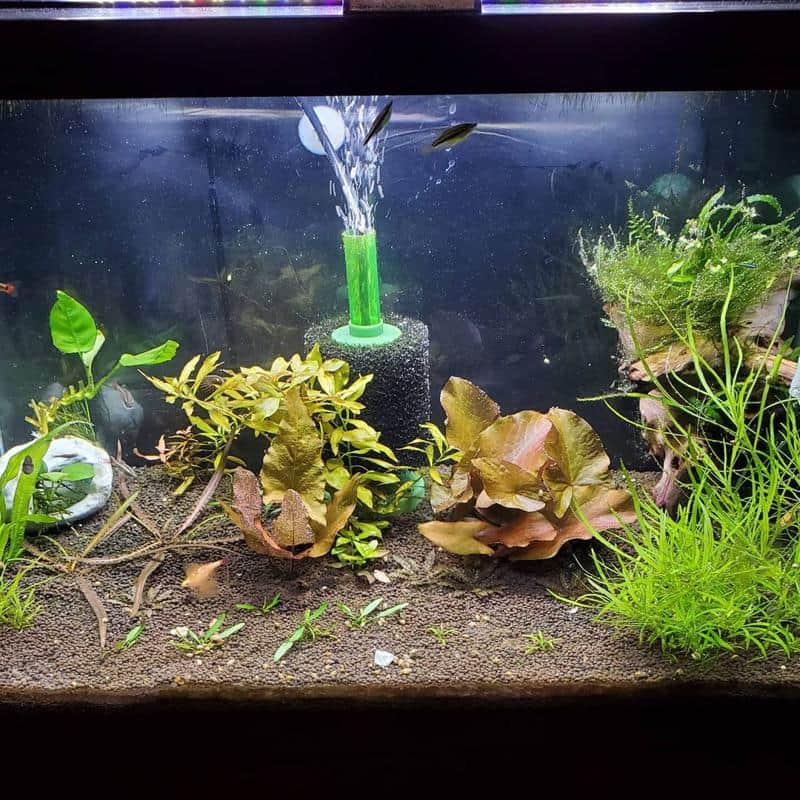With their water-absorbing capabilities, sponges are often used as a cleaning tool or as a part of our hygiene kit.
Originally, they were derived from sea sponges. But with commercialization, natural raw materials are now replaced with synthetics.
The availability of synthetic sponges allows it for a wide range of applications, like a kitchen sponge or a body sponge. But how about a sponge filter for aquariums?
Are they effective? Let’s find out in this article.
Fun fact: Ancient Greek Olympians were the first to use sponges. Before the games, they bathe themselves with a sponge soaked in oil and perfume.
Sponge Filter: What It Is

Have you noticed a sponge inside someone’s aquarium? What’s it doing there? Is it there by accident?
Sponges in aquariums are intentionally set-up to serve a purpose. It cleans your tank by trapping and filtering out suspended particles in the water.
While some models are encased in plastic canisters, most sponge filters are directly exposed and bare naked in the water. The reason for this is to create maximum surface area exposed to the water, which in turn, filters out more waste and unwanted particles.
Sponge filters are popular amongst aquarium hobbyists. They are cheap with few parts to be attached during installation.
Mechanical Filtration in Sponge Filter

The sponge filter alone can work by itself. However, it will take time to see their filtration effects. In the case of a standalone set-up, the filtration rate is slow as it is dependent on the natural flow of water.
To maximize its filtration potential, sponge filters work best when attached to an air pump or a powerhead.
In the case of air pumps, they emit air in the form of bubbles. As the bubbles ascend towards the surface, water is sucked along and passes through the membrane of the sponge.
Initially, suspended particles are trapped in the membrane. But with the continuous flow of water created by the upward movement of the bubbles, particles are collectively deposited in the strainer which also acts as the skeletal structure of the sponge.
The end product of a sponge filter powered by an air pump is clean filtered water going out of the exhaust end of the lift tube.
In the case of powerheads, a sponge filter can be attached to the intake pipe. As water is sucked in, it is filtered through the sponge before entering the powerhead device.
Biological Filtration in Sponge Filter: a By-product of Mechanical Filtration
Initially, biological filtration will not occur in sponge filters. However, as sediments and other particles are accumulated, it becomes the perfect breeding ground for microorganisms, like bacteria.
By this time, you should be aware that sponges have numerous interconnected membranes and this labyrinth of maze is highly ideal for bacterial growth.
When the population of microorganisms flourishes in the sponge filter, it now becomes a biological filter or biofilter. In this type of filtration, bacteria living in the sponge breaks down pollutants making the water less toxic. A perfect example of this is the degradation of ammonia into nitrites.
Fun Question: Which type of filtration is not possible in sponge filters?
Among the 3 types of tank filtration, chemical filtration is not yet incorporated in sponge filters.
The reason for this is the absence of a chemical media, like activated carbon which absorbs chlorine and hydrogen sulfide.
But come to think of this: why need chemical filtration when your mechanical and biological filters in a sponge filter are working well.
Benefits of Sponge Filter

On top of what has been presented, sponge filters come with a variety of benefits that other filtration systems cannot provide.
Customizable
Sponge filters are not just for air pumps. They can also be used with other water circulation devices, like a powerhead filter.
Regardless of the type and model of the powerhead filter, a sponge filter multiplies its filtration effectivity.
Attached to the intake tube, the sponge filter ensures that water is already cleaned before it enters the powerhead itself. This means that it lessens the load of the powerhead filter.
Moreover, with the suction cups of the powerhead filter, you can customize the placement of the sponge filter allowing you to target a desired area.
Sheltered Filtration
Not unless you can control the flow rate, filtration can sometimes be strenuous to your fish.
In the case of juvenile fish, the possibility of being sucked in standard tube filters is high. This is the reason why you see small fish inside your filter tube.
With sponge filters, the membrane acts as a shield against young fish. This sheltered filtration by sponge filters is also great for fish that are less tolerant to current and strong suction, like your betta fish.
Old Sponge as Biofilter in New Tanks
Controlling ammonia and nitrites in new tanks can be tricky. By placing an old sponge in the new tank, it will reduce the sudden increase of organic matter.
We have to remember that an old sponge is fully-loaded with microorganisms that have the power to naturally break down toxins commonly occurring in new tanks.
Fun Question: Why do expert aquarium hobbyists foster a lot of sponge filters?
They use old sponge filters in setting up emergency tanks, like in the case of a fish isolation. Nobody knows when an emergency will happen and it’s best to have a fully grown sponge ready to help.
Setting up a Sponge Filter
Along with other tank equipment and accessories, sponge filters need setting up. For the sponge filter itself, make sure that the strainer is already fitted internally. But in most cases, you don’t need to do this as manufacturers have already fitted the strainer during packaging.
Be prepared to have along with you a source for water flow. In this case, you can either use an air pump or a powerhead.
Setting up With an Air Pump
For air to flow from the air pump to the sponge filter, you need an air hose. After attaching the air hose in the air pump, insert the other end of the hose in the lift tube and into the strainer.
In most cases, an air stone is placed inside the strainer and attached to the air hose. Not only will it break down large bubbles, it will act as a stopper for the air hose and keep it in place.
Once fully assembled, place it to your desired position. Turn on the air pump and let the filtration start.
With a powerhead
There are 2 main differences in setting up a sponge filter in a powerhead. First, instead of using air hoses in air pumps, sponge filters are directly attached to the intake pipe of the powerhead.
Most problem encountered in powerheads is the mismatch of tube diameter. But in our experience, using the lift tube and tightening it in the intake pipe would secure its attachment.
The second difference is the absence of an air stone. Since there is no air hose, the addition of an air stone in the strainer is literally not needed in a powerhead setup.
Check this video for more information:
Maintenance and Cleaning of Sponge Filter
Sponge filters are effective as long as the membrane is not clogged with particles. It will continue to filter out particles up to a point that water cannot pass through and filtration ceases.
Especially if it’s dark colored, sponge filters may be hard to detect if it’s already clogged. Buy why wait for clogging to occur when you can make a frequency and schedule its cleaning before it becomes clogged.
After a few weeks or during water change is the perfect time to clean your sponge filter.
In general, a sponge filter needs to be taken out of the tank for cleaning. Once out, place it in a small container with water. Initially, squeeze the sponge to dislodge the particles trapped in the membrane.
After squeezing, try to dismantle the filter unit, which in effect, will expose the strainer. You will be surprised to see that more particles are stored in the strainer.
Wash and rinse thoroughly. Do not use detergent. You can use a small brush to take off hard particles.
After cleaning, do not let it dry completely. Otherwise, the sponge membrane will become brittle and less effective when it comes to absorption. Assemble all parts together and place it back to the tank.
- If connected to an air pump
Before cleaning, turn off and unplug the air pump. Slowly grab the air hose.
Do it gently and do not rush in taking out the sponge filter. Otherwise, you will stir-up the particles settled inside the filter and release it back to the water.
- If connected to a powerhead
Unplug the powerhead. Once turned off, you can either directly detach the sponge filter or take off the whole powerhead device.
Again, do it gently to prevent particles from releasing back in the water.
- For 2 or more filters
Some tanks have 2 or more sponge filters. If you have this kind of set-up, do not simultaneously clean 2 or more filters.
Clean it one by one.
In this way, the sponge filters left behind assures that mechanical and biological filtration is still going on even if it is your cleaning day.
Read More: Do Goldfish Need an Air Pump?
Summary of the Pros and Cons of Using Sponge Filter
| Pros | Cons |
| – Cheap
– Effective – Provides mechanical and biological filtration |
– Doesn’t provide chemical filtration
– Inaesthetic – Takes time and effort to clean – Needs air pump or powerhead to effectively work |
Conclusion
In general, cheap products do not work well. But in the case of sponge filters, while they are cheaper than other forms of filtration system, they are highly effective.
The only downside of a sponge filter that hinders you to use is its inaesthetic characteristic. Frankly, they don’t look good in your tank.
But why compromise filtering prowess with aesthetics? After all, a simple landscaping design (or covering with some aquatic plants) will enhance the beauty of a sponge filter.